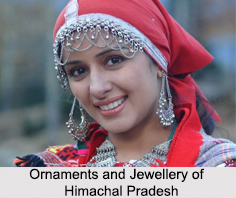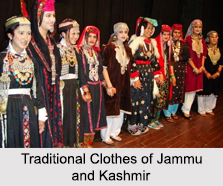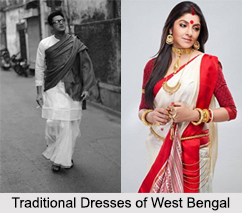 Traditional Dresses of Himachal Pradesh reflect an awesome diversity owing to the plethora of culture and religion. The attire of Himachal people is very beautiful and vibrant. And it is made according to the harsh weather conditions that linger all year round. Again the costumes of each community are different, be it the Hindu Brahmins, the Rajputs, and the tribal people like Gaddis, Kinnauras, Gujjars, Pangawals and Lahaulis.
Traditional Dresses of Himachal Pradesh reflect an awesome diversity owing to the plethora of culture and religion. The attire of Himachal people is very beautiful and vibrant. And it is made according to the harsh weather conditions that linger all year round. Again the costumes of each community are different, be it the Hindu Brahmins, the Rajputs, and the tribal people like Gaddis, Kinnauras, Gujjars, Pangawals and Lahaulis.
Hand-woven excellence is the hallmark of the traditional dresses of Himachal Pradesh. The native women are famous in weaving headscarves. The utility shoes made from grass, are perfect for keeping the feet warm.
Traditional Dresses of Himachal Pradesh for Men
There are mainly two classes in which the community of Himachal Pradesh has been divided; Rajput and Brahmins. By heritage, the Dhoti-clad Brahmin priests roam around in Kurta, overcoat, waistcoat, turban, i.e., Pagri, and with a hand towel, placed upon the shoulders and with a valuable copy of Panchangam.
 The Rajputs wear body-hugging Sherwani-Churidar pyjamas, a long silk overcoat, a starch-stiffened turban and shoes with pointed edges. The overcoats are designed with leather and gold threads which help them keep warm. They boast thick moustaches and a dignified frown in the forehead-region, as a symbol of pride and honour among the Rajputs. Now a days, though not so much in vogue, but previously the Rajputs adhered to the Purdah system for their women. Their wives and daughters used to venture out within the enclosed confines of curtained palanquins.
The Rajputs wear body-hugging Sherwani-Churidar pyjamas, a long silk overcoat, a starch-stiffened turban and shoes with pointed edges. The overcoats are designed with leather and gold threads which help them keep warm. They boast thick moustaches and a dignified frown in the forehead-region, as a symbol of pride and honour among the Rajputs. Now a days, though not so much in vogue, but previously the Rajputs adhered to the Purdah system for their women. Their wives and daughters used to venture out within the enclosed confines of curtained palanquins.
For occasions and festive ceremonies, men wear new kurta pyjamas along with embroidered caps or turbans and sometimes shawls.
Traditional Dresses of Himachal Pradesh for Women
The traditional dresses of the women hailing from the Brahmin and the Rajputs clans are quite traditional. Rajput women wear long kurtas stretching from their neck to their toe. They normally dress themselves in Kurtas, Ghagra Lehenga Choli and “Rahide†which is a nice crimson headscarf decked with golden fringes. The farmers and worker classes required to toil go for kurta, a loincloth and a cap. They provide to long pyjamas, for attending ceremonies like marriage ceremonies or special occasions, such as festival. The Chamba folk of Himachal Pradesh are very fond of adornment. The women folk decorate themselves with head scarves. These scarves are usually made of bright printed cotton cloth and knotted at the back.
Traditional Woollen Dresses of Himachal Pradesh
Wool weaving acts as a major vocation in Himachal. These weave-ace people are the dexterous creators of exclusive shawls. These shawls are famous for their elegance and smooth textures, as well as fascinating patterns, are assets for any costume-lover. The soothing suppleness of the renowned Pashmina shawl is the specialty of the handlooms of Himachal Pradesh. Manufactured from the hair of Pashmina goat, these shawls find their demand worldwide. Among the favourite types of shawls, "Dhobroo" and "Pattu" are the leading. The fancy needlework available on these shawls has its source in the Kangra and Chamba schools of paintings. Thapada is also a broad shawl with marvellous embroidery. Embroidered blouses and caps gives a glimpse of the commendable taste of the Himachal inhabitants. The embroidered caps of the Kulu, Sirmaur, Kinnaur District and Lahaul district are all brands of skilled craft by themselves. The striking shawls originating from Kulu Valley, Lahaul, celebrate the ages-old Pahadi designs.
Ornaments and Jewellery of Himachal Pradesh
Peculiarities in kinds of feminine ornaments are well demonstrated by the bangles and rings produced from horsehair. These are worn by the Chamba women. There are many ornaments and jewellery that are worn by both Brahmin and Rajput women of Himachal Pradesh. Some of them are "Chakk" (silver domed and worn on the top of head), "Chanderhar" (necklace or pendant worn in weddings), "Chiri" (similar to maangtika), "Toke" (wristbands), "Pari" (foot necklace), "Jhumka" (earrings) etc.
Thus, the splendid traditional dresses of Himachal Pradesh owe a lot to the impressive craftsmanship of the prolific weaving-talents and the outstanding handlooms of the state.





















